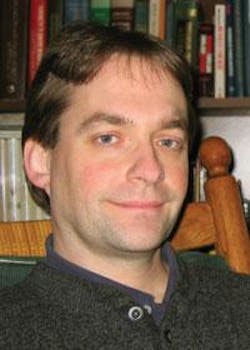
In his unassuming way, Bill Telford has pushed the capabilities and impact of flow cytometry—influencing the progress of both people and instrumentation.
Telford describes himself as “a staff scientist at the National Cancer Institute, which is part of the National Institutes of Health (Bethesda, Maryland). I run a flow-cytometry core laboratory,” he says. “We operate a large series of flow cytometers—analyzers and self-sorters—in support of cancer researchers at the National Cancer Insititute. We support a wide variety of projects encompassing HIV, cancer studies, bone-marrow transplants, and also basic cell-biology studies.”
One of his efforts is to introduce new laser technology into flow cytometry. “There are thousands of fluorescent molecules that could be useful for flow cytometry if we had good laser excitation for them.” While solid-state technology has enabled the proliferation of lasers beyond the traditional 488 nm blue-green, commercial instruments are still largely limited.
“We’ve tried aggressively to collaborate with laser manufacturers and encourage development in some of the wavelength ranges that typically have not been commercially viable,” Telford explains. “It’s gotten us access to a lot of interesting lasers, and we’ve been able to analyze a lot of probes we hadn’t been able to before.” One example is a class of green fluorescent proteins derived from invertebrates such as jellyfish that are important in biomedical research. Until recently such proteins were beyond the reach of cytometry because good green, yellow, and orange lasers weren’t available. But now, thanks in large part to Telford, a new toolbox is available. “We can analyze virtually anything,” he says. “There are almost no limits.”
Telford earned his Ph.D. in immunology from Michigan State University, using flow cytometry in his research. “It was very intriguing to think you could look at a single cell and get that much information, and then see a hundred thousand cells in a few minutes and get so much information.” Afterward he ran a flow-cytometry lab for Cornell University. “That’s been my focus for the last 10 years or so.”
He describes his college years in the 1980s as “a very hot time in immunology” because immune-system components were being elucidated and the genes were being cloned. And flow cytometry was developing in tandem. Louis King, cytometry director, was Telford’s mentor at Michigan State and he was also greatly inspired by Professor Pamela Fraker, a recent National Academy of Sciences inductee, who applied immunological studies to nutrition research. The school had limited funds, but Telford says the older equipment “probably helped me learn more about what flow cytometry could do. It was all out in the open, and you could change and modify it.”
Telford shares his enthusiasm globally, training students in India, Turkey, and Russia. “We have an active exchange program,” he says, noting that his group established a sister laboratory in Moscow.
For the future, Telford is excited about the portent of increased computing power, integration of cameras into flow cytometers (for correlated imagery), and access to more wavelengths, including supercontinuum lasers that generate white light.
But he’s also motivated by the impact of his work at the NIH. “It’s very translational: the work that goes on in the laboratory gets moved to the clinic very rapidly,” he says.
And he enjoys working in the flow-cytometry community. “There’s a lot of emphasis on training the next generation, and it’s a nice, supportive community of researchers to work in.”
About the Author

Barbara Gefvert
Editor-in-Chief, BioOptics World (2008-2020)
Barbara G. Gefvert has been a science and technology editor and writer since 1987, and served as editor in chief on multiple publications, including Sensors magazine for nearly a decade.